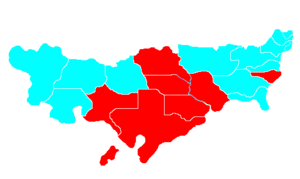2016 Newreath Presidential Election
| ||||||||||||||||||||||||||
410 Electoral College Votes 206 votes needed to win | ||||||||||||||||||||||||||
|---|---|---|---|---|---|---|---|---|---|---|---|---|---|---|---|---|---|---|---|---|---|---|---|---|---|---|
| ||||||||||||||||||||||||||
 Electoral College Map [Cyan = Carter] [Red = Hanley] | ||||||||||||||||||||||||||
| ||||||||||||||||||||||||||
The 2016 Newreath Presidential Election was held on November 10th, 2016. The election was the first in which a sitting Presidnet or Vice-President was not on the general election ballot. Incumbent Republican President Branden Nielson, suffering from disastorous polling, was primary challenged in the Republican Presidential Primaries and lost re-nomination. The liberal Nominee, Senator George Carter of Blythe, and his running mate, Governor Andrew Richardson of Berkshire, were elected President and Vice-President respectively. They defeated the republican ticket of businessman and billionaire Charles Hanley and Representative Dayton Hatfield of Crawford
Primaries
Brandel Nielson, the incumbent Republican President, had been suffering in the polls since his election in 2012. He led his party to a disastorous defeat in the 2014 midterm elections which saw the Republicans lose their majority in the House of Representatives for the first time in a decade and reduce their standing in the Senate. President Nielson was privately advised by party leaders to step aside and let his Vice-President, Laura Chambers, run for President instead. Nielson refused and sought re-nomination. The day after he announced his re-election campaign, the congressional republican leadership team announced they would not support him, a damning public blow to his campaign. Vice-President Chambers, a loyal friend of Nielson, refused to run against him. Billionaire businessman Charles Hanley decided to run and easily defeated Nielson in the early states. Nielson was forced to drop out of the race before West-Friday and Hanley easily secured the nomination. However, the party leadership condemned Hanley's divisive rhetoric and many were wary of endorsing him. Hanley managed to stir up the Republican base which led to many congressional leaders of the republican party losing primary battles themselves to loyalist supporters of the new nominee, Charles Hanley. The victory of Hanley in the 2016 Republican Presidential Primaries caused a major shift in the Republican Party.
The Liberal party had now lost the previous 3 presidential elections and were becoming even more desperate to re-take the State House (presidential residence). Due to Nielson's unpopularity throughout his 4 year term, the liberal party had already begun rallying around George Carter, a clear establishment figure in the liberal party who had been a congressman and was now serving as a Senator for the state of Blythe. As the party had already begun rallying around him since 2014, the liberal party primary was widely seen as a coronation and Carter easily won the nomination.
General Election
Whilst Charles Hanley had completely overturned the republican party and stirred up the republican base, the rest of the country were turned off by his aggressive rhetoric and lack of government or military qualifications. Hanley also faced a republican party establishment which were not supportive of his policies or rhetoric and were still angry about his supporters winning primaries against incumbent republican congressional leaders. As a result, Senator Carter was able to position himself as a continuity candidate who brought experience, level-headidness and stability to the presidency. Carter went on to win the presidential election.
Aftermath
The Carter victory was widely seen as a turning point in Newreath politics. The last 4 years had marked the end of the traditional, bipartisan, compromise style politics that had dominated federal politics for the last century. Historians now regard the end of Matthew Dawson's presidency as the end of that era. President Nielson, whilst hoping to continue that style of politics, was unable to command the same authority in the republican party as his predecessor and with a more combative liberal party in the congress, bipartisanship and compromise were no longer on the table.
The 2016 election itself was seen as the pinacle of the new division and partisanship in federal politics. Over the past 4 years, the Republicans and Liberals had become more entrenched in their positions and federal politics had become more partisan and tribal with the norms and traditions "going out the window". The election turned out to be the most divisive, fierce and negative election the country had seen in decades but Carter's victory over Hanley was seen as a turning point. Hanley was widely seen as a proponent of the divisiveness which led to many moderate republicans turning against his candidacy and voting for the liberal nominee or not voting at all.
In the subsequent 2018 mid term elections, the supporters of Hanley who had primaried incumbent republicans were primaried themselves by establishment wing republicans. The 2018 mid terms was seen as the final sign that the country had moved away from the 2012-2018 era of politics.

